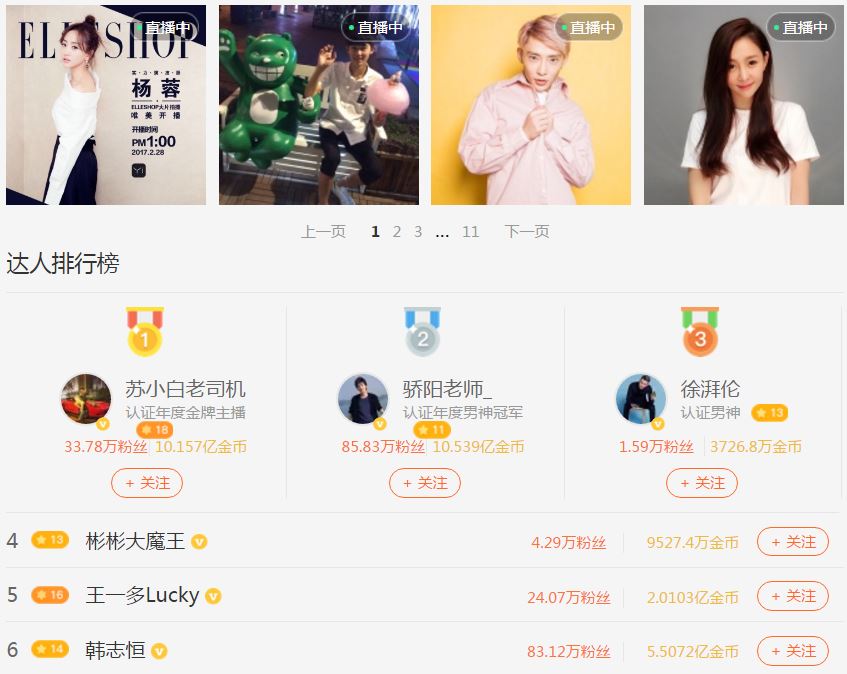In the last 2 plus years, live streaming in China has been reshaping the ways people use mobile internet becoming the latest craze in the country. The phenomenon has also given rise to a new type of live-streamer KOLs (key opinion leaders).
According to China Internet Network Information Center, the number of live-streaming users reached 325 million as early as in 2016 - nearly half of China’s total internet population of 710 million. According to a report released by China International Capital Corporation, the market size of China’s streaming industry reached 25 to 30 billion yuan in 2018, including hosting platforms, video production and other support services.
It is estimated that Chinese personal live streaming market will be worth $8 billion in 2019 – only half the size of the country’s mobile gaming market.
Panda TV, Douyu Tv, YY, Inke and Momo, portal and micro blogging giant Sina, Youku, Tudou, LeTV, iQiyi, Yizhibo are just some of the Chinese live streaming platforms.
Most live streamers broadcast their daily lives, share activities like playing games, telling jokes, putting on makeup or giving away fashion tips. For many, it has become a full time job.
Curiously, live streaming in China is more popular in lower tier cities rather than 1st tier ones which probably reflects the fact the extra income it provides goes further there than in more expensive cities:
Investors also feel excited about new opportunity: the reports lists 14 live streaming startups that have raised between 1.5 and 390 million dollars each.
Why live streaming in China has become so attractive?
The main reason is its proven monetization process, in other words a relatively easy way to make some cash. In fact, many Chinese users are making more money live streaming than with their regular jobs. It has even provided an extra income to people living in the country side as The Economist has recently reported.
How do Chinese live-streamers make money?
There are generally two ways: virtual gift selling and advertising.
Virtual Gifts
Virtual gifting is how viewers reward streamers for good performance or interesting content. Gifts accrued by streamers then become a streamers’ virtual assets, which can be cashed out based on the specific conversion rates set by live streaming platforms.
During cash out process the platform takes its share, often more than half which is one of their revenue sources.
Most full time streamers make about 500 dollars per month on average from virtual gifts while some can earn up to 2,000. This is not however the only income they can potentially generate. Some of the top streamers also sell goods or act as affiliates. The most successful ones are able to pull income of 20,000 dollars and more from advertising contracts and affiliate commissions.
Advertising
This is another opportunity to earn income for streamers as well as another lucrative revenue source for live-streaming platforms. As more traffic they receive – higher the advertising value of those sites. Ecommerce platforms like Taobao and JD.com are already taking advantage of the phenomenon with their own live streaming in China. According to Taobao Live, the Conversion Rate of Content on the live-streaming site is 32 percent which is practically unheard of in the business.
Some well-known personalities and celebrities help attracting more viewers to those platforms that can results in thousands and, in some cases, millions of purchases in the matter of hours.
According to CNBC Asia report, the trend has spawned support services, such as one run by Ma Tingting, 25, who manages an agency of more than 100 contracted live-streamers in Chengdu, China.
“E-commerce stores come to me and I will assign live-streamers to promote their products,” Ma told CNBC Asia. “Top streamers in my team can help sell more than 1,000 items within a day.”
Live streaming in China is giving rise to a new type of KOLs (key opinion leaders) that can drive and engage with audiences in real time. Also, this type of KOL can often come across as more genuine and more responsive – something that is often not the case with KOLs operating on WeChat or Weibo.
If live-streaming becomes another powerful marketing tool, the effectiveness and the reach of live streaming KOL will only grow. There is no doubt that those users who already got into live-streaming business and are building loyal following are soon going to be sought after by brands, perhaps at the expense of traditional KOLs.
If you are a foreigner and would like to get into live streaming in China we got bad news for you. According to Mashable, foreigners are now having their accounts suspended on big streaming platforms. As it turns out, Chinese officials enforced a new set of regulations last year, stating that non-Chinese streamers had to first apply to the Ministry of Culture before starting their own live-streaming channels.







